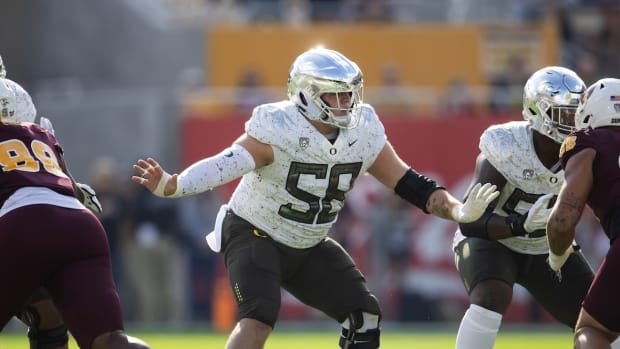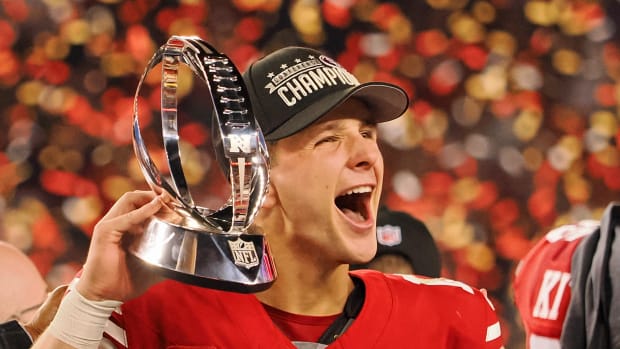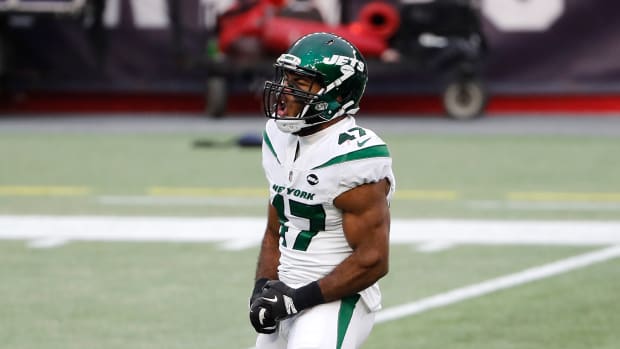Buccaneers Preview: The Right Man for the Job
Lovie Smith is all smiles for his return to the NFL. (Phelan M. Ebenhack/AP)
Throughout the preseason Andy Benoit will provide in-depth breakdowns of all 32 teams, in reverse order of 2013 finish. Today, the Tampa Bay Bucs …
Defense
In his first year as Bucs coach, Lovie Smith is implementing what, frankly, seems to be an outdated model. He’ll do battle with a caretaking quarterback and vanilla, zone-based defense. We haven’t seen this formula truly prosper since 2006, when Smith took Rex Grossman and the Cover 2 Bears to Super Bowl XLI.
But while this approach might seem shaky on the surface, many feel it’s a step forward from the even more outdated one put forth by previous coach Greg Schiano, who believed strongly in running the ball and, according to some, treating professional athletes like high schoolers. Smith’s laid-back demeanor is almost the antithesis of Schiano’s. With five winning seasons to his name, Smith has the NFL pedigree his predecessor did not.
Smith also has immense talent on his roster—in fact, enough talent that a simplistic scheme presents the best chance at winning. A coach’s rule of thumb: the more talent you have, the simpler your approach can be. It leaves players with ample time to hone and perfect the basics that they impose on opponents come Sunday.
Having spent more than $55 million guaranteed in free agency and picking near the top of the draft, the Bucs are more than talented enough to make the biggest jump in the league this year and compete for an NFC South title. (Interestingly, six times in the last 11 years the division has been claimed by the team that finished fourth the previous year.)
Gerald McCoy (93) and Lavonte David (54) lead a talented Bucs defense. (Scott Cunningham/Getty Images)
Defense is Smith’s side of the ball. It’s possible he will diversify his scheme like he did in his final year with the Bears. But given what he’s said in recent profiles and given the hiring of Leslie Frazier at coordinator, indications are he’ll run a lot of what many will describe as a “Tampa 2.” That is, a Cover 2 only where the middle linebacker, rather than land-marking to a zone spot, carries however deep the furthest inside receiver goes.
But with the proliferation of unbalanced offensive spread sets, most Tampa 2s these days morph into modified versions of other zones. Smith’s scheme will be no exception. But however the zone shakes out, it typically will be straightforward and 4-3-based, with the focus on execution, not trickery.
As Smith was reminded the hard way at the end in Chicago (and this may have been why he diversified schematically), such an approach only works if you have a front that can generate its own pressure. Recognizing this, Smith and new general manager Jason Licht spent $24 million guaranteed on free agent defensive end Michael Johnson. The sinewy ex-Bengal will not be a 15-sack force (take out his 11.5 sacks in 2012 and he’s averaged just 3.75 a season in his career), but he will provide an extremely athletic, versatile and, at times, downright destructive bookend to Adrian Clayborn. It was surprising the Bucs did not exercise a fifth-year option on Clayborn, one of the game’s preeminent bull-rushers.
Clayborn also is very adept on long stunts (looping around at least two defensive linemen), which was one of the many dominant slant-and crash concepts this Bucs defensive line featured under Schiano. It helps that Gerald McCoy has blossomed into the elite three-technique that he was expected to be as the third overall pick in 2010. McCoy’s athleticism has never been a question; finally catching up to that is his sense for technique, particularly hand usage.
This season McCoy consistently will have a potent force alongside him. In the base package, second-year pro Akeem Spence brings good deceptive movement skills to nose; in nickel is free agent pickup Clinton McDonald, who blossomed into a tremendous gap penetrator for Seattle last year.
At linebacker, Smith understands the importance of guys who can run, having coached Brian Urlacher and Lance Briggs. He has one in Lavonte David, who has a chance to be as good as anyone Smith’s ever coached. David brings good short area athleticism, scintillating speed and range and a nose for the ball that’s punctuated by quick closing ability on tackles. He also happens to be a dynamite blitzer who’s coming off a seven-sack season. Considering that Jonathan Casillas is also a potent blitzer, Smith may be tempted to diverge from some of his straight four-man rushes in certain third-down situations. In those situations, he’ll still keep two linebackers on the field. Base Mike ’backer Mason Foster had these duties last season, though free agent pickup Dane Fletcher is better equipped to handle them.
Smith would have the safeties to support any experimental whims. The previous regime spent the seventh overall pick in 2012 on Mark Barron precisely because he could defend tight ends man-to-man and also make noise in the box. After an up-and-down start to his career, Barron started to come on last season, though in part because of his comfort playing linebacker in Schiano’s and coordinator Bill Sheridan’s dime package. This year, Barron will play in deep space more often. So will Dashon Goldson, a fierce (sometimes reckless) downhill hitter who can’t blow as many coverages as he did a year ago.
What could keep Smith married to his Tampa 2 are his cornerbacks. They’re perfect for the scheme – which is both a compliment and slight. Free agent Alterraun Verner ($14 million guaranteed) is no Darrelle Revis, but as his five interceptions in Tennessee last year attest, he’s an excellent read-plant-and-drive defender, which is what this off-coverage zone scheme requires. Smith typically has his corners play the same side of the field every snap, though with Verner being 5-10 and fellow starter Johnthan Banks being 6-2, it’d make sense for them to match up to specific receivers. That, however, would result in Banks following opposing No. 1 receivers—something he has the length but not the swiveling hips and quick feet for. What Banks lacks in fluidity he often makes up for in awareness; it’s rare for a young corner to have such a refined understanding of route designs.
Josh McCown gives Tampa a veteran caretaker to run the offense. (Chris O'Meara/AP)
OFFENSE
Tampa Bay’s offense is outdated only in that it’s trying to make due with a placeholder quarterback, Josh McCown. Schematically, it’s widely expected that new coordinator Jeff Tedford, a longtime cutting-edge offensive architect at Fresno State and California, will install a voluminous spread system.
Having learned more than a few systems during his 12-year, seven-team NFL career, McCown figures to be more than capable of picking up whatever Tedford sets down. Still, it’s surprising that second-year quarterback Mike Glennon was never even in contention for the job. Glennon showed pocket poise, solid physical tools and, by rookie standards, a nice understanding of NFL coverages in his 13 starts last season. His grasp on protection concepts could use improvement, but so far he has only worked with an injury-depleted offensive line and mostly backup running backs.
With McCown you at least know what you’re getting. Though a tad quick at times to use his subtly decent mobility to go sandlot, he is generally a patient dropback passer with a good sense for how his actions synch to various route designs. He was fundamentally sound in Bears coach Marc Trestman’s scheme last year.
McCown also benefitted from having two plus-size star receivers whom he could just heave balls towards. Incredibly, the Bucs may be the only other team that offers that, with Mike Evans working opposite Vincent Jackson. Evans only played on the outside at Texas A&M and figures to initially do that here given Jackson’s development as a movable “Z” and highly productive slot receiver.
With an uninspiring competition between Louis Murphy and Chris Owusu for the No. 3 job, expect Tedford to often employ two tight ends in his base. One of those tight ends, Tim Wright, is a former wideout who can consistently beat safeties and even cornerbacks when detached from the formation. Wright has the body control and quickness to blossom into a top-five pass-catcher at his position over the next two years.
2014 Team Previews
Andy Benoit dives deep with breakdowns of all 32 teams during the preseason.
PREVIEWS
At the other tight end spot, second-round rookie Austin Seferian-Jenkins should capture a starting job ahead of Luke Stocker and the unimaginative Brandon Myers. At 6-5, 260, Seferian-Jenkins has the girth to move bodies as an in-line blocker. Though Tedford is known as a quarterback whisperer, working under Lovie Smith he’ll have to commit to having a steady ground game.
In an effort to keep ballcarriers fresh, the Bucs will use their entire stable of running backs, with third-year star Doug Martin at the forefront. It was a blessing in disguise for Martin to tear a shoulder labrum last year; when he went down, the Bucs were on their way to 0-6, so he avoided a half-season’s worth of wasted tread on his tires. Martin’s superb quickness through the hole will be tempting for Tedford to call on often, but if Smith and the front office were willing to wear him down, they wouldn’t have spent a third-round pick on Charles Sims. He joins a rotation that already has Mike James (a laterally quick second-year man coming off a fractured ankle) and Bobby Rainey (a poor man’s Darren Sproles).
Chaperoning these backs and protecting McCown is a revamped offensive line that’s undergone a potentially dramatic upgrade at left tackle. Out is the inconsistent, average-at-best Donald Penn; in is the light-footed Anthony Collins, a seventh-year pro who looked very promising in his seven starts for Cincinnati last year. Collins signed for $30 million over five years. Two years ago, the Bucs made an even more expensive investment at guard, with free agent Carl Nicks signing for $31 million guaranteed. Career-threatening toe injury complications limited Nicks to just nine games before his release earlier this month. His absence leaves the interior left side of the line dubious, which is just like the rest of the line save for right tackle Demar Dotson. Center Evan Dietrich-Smith has improved as a group-oriented run-blocker but remains questionable in isolation and pass protection; right guard duties are up in the air and will likely be reassigned as the season goes on.
SPECIAL TEAMS
Kicker Connor Barth was out of the league last year nursing a torn Achilles. Michael Koenen has ranked in the bottom quarter of net punting each of the last two seasons but is still regarded for his versatility in handling kickoffs and moonlighting as a long-distance field goal specialist. It’s an open competition for return duties.
BOTTOM LINE
If McCown can do here what he did in Chicago, the Bucs will make the playoffs. They’re loaded with weapons on offense and have the requisite speed on defense for Smith’s zone scheme.









































